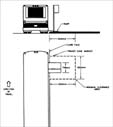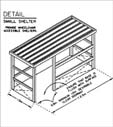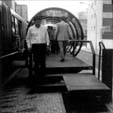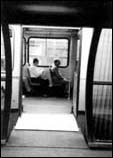
Mobility for all
Getting to a transit stop
by Tom Rickert
Entire guide as a PDF file (1.43 MB)
Access to bus stops
All passengers benefit from transit stops and transit terminals, which are safe and accessible. Approaches to transit stops should be on wellpaved or level surfaces. Curbs should be ramped for easy access and platforms for trams or trains should also be ramped. The photo above left illustrates a tram stop in San Francisco.
The Canadian diagram above middle illustrates access to transit stops in rural areas or areas where roads may be unpaved. Where possible, the transit stop itself should be paved, with curb ramps for those with mobility difficulties. If this cannot be done, at a minimum transit stops should be entirely off the road so those passengers can wait safely. Even if a paved sidewalk is not available, a 2-meter or longer raised curb between the road and the passenger waiting area can provide greater safety, assist mobility-impaired persons to reach the first step of a bus, and provide orientation to blind persons or those who are partially sighted.
Transit stops should be marked with largeprint signs to assist those passengers who are partially sighted. Route and schedule information should be displayed to assist all passengers. Ideally, transit stops should provide separate waiting areas for passengers that do not conflict with nearby pedestrians, as shown in the diagram at above right.



Shelters and waiting areas
Accessible transit shelters and waiting areas also benefit all passengers. Persons with mobility aids can easily enter the shelter.
The Canadian diagram above left incorporates several features, which assist disabled persons. These features include seating for waiting passengers, a tactile warning strip to assist the blind person shown waiting with her guide dog, a curb cut to assist persons crossing the street to the bus stop, and measures to prevent newspaper boxes and other obstacles from blocking access to the stop. Route and schedule information is also displayed.
A small low-cost shelter, accessible to wheelchair users, is shown in the diagram at above right. The diagram in the middle shows recommended clearance so those wheelchair users can board a bus, which has a wheelchair lift or special ramp.




Curitiba, Brazil: A city committed to accessible transit
Persons with disabilities can enter Curitiba's "bus tube" waiting areas along with other passengers, using a flat surface or a small lift as shown in the two photos to the left. Bus tubes improve access, protect all passengers, and permit fast boarding because passengers have already paid their fares upon entering the bus tube to await their bus.
Articulated buses on Curitiba's main routes stop alongside the bus tube stations. Bus drivers lower special bridges over platform projections in order to provide a smooth entrance for wheelchair users and all others between the floor of the bus tube and the floor of the bus as shown in the two photos to the right. In addition, four lift-equipped bus lines connect with main routes, and lift-equipped taxis serve points of special interest to disabled persons.